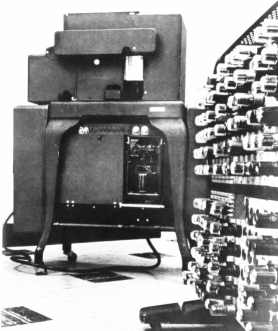The IBM 603 Electronic Multiplier

Photo: from [4].
I think most of you have heard of the electronic multiplying punch which is now one of the standard IBM machines. It performs a multiplication in 17/1000 of a second. Since multiplication is the bottleneck in scientific computing, there is a great effort to develop machines of higher and higher speed. We started with the older type wheel calculators which are still doing most of the scientific work. We have experimental relay calculators which are coming into use. We have the Type 603 Electronic Calculator which is also coming into use. With the 603 the aim was not the make it as fast as possible, because of the importance of recording, etc., but rather to assure reliability and simplicity. Of course, everyone is now looking forward to the day, perhaps not far off, when it will be possible to combine electronic speeds with the machines of the capabilities of the IBM Sequence Calulator. One such attempt at the University of Pennsylvania has resulted in the Eniac, which has 20,000 vacuum tubes. While it is tremendously fast, it is still not a complete calculator ...
Here Eckert is alluding to Watson Lab's own SSEC, which would be unveiled in just four months!
Also see: IBM 604, IBM 607, the Northrop CPC Prototype, and a color photo of the 603 in IBM's "Attic". And a more recent IBM exhibit HERE.
And an IBM 100th anniversary piece on the 603 HERE.
| Columbia University Computing History | Frank da Cruz / fdc@columbia.edu | This page created: January 2001 | Last update: 28 March 2021 |
